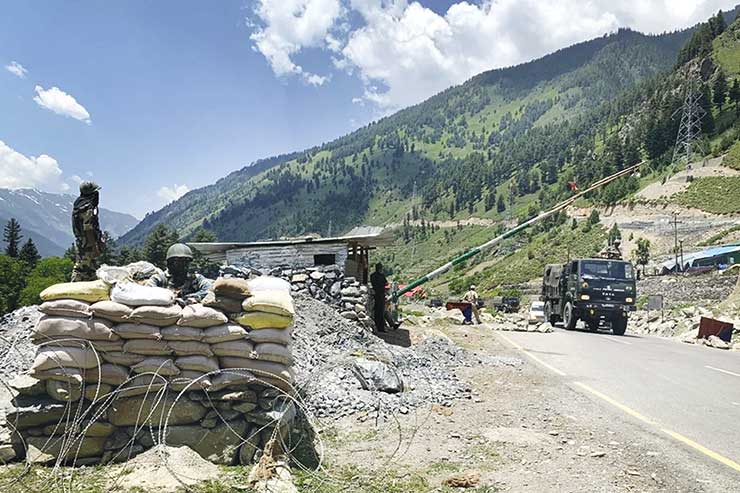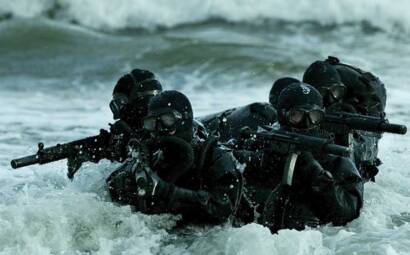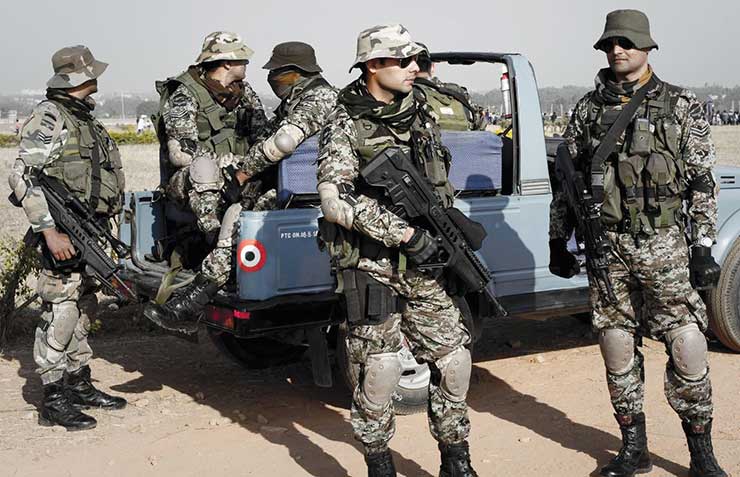
To deal with a bully, you have to look him in the eye. And, sometimes, give him a bloody nose as well. Much has been written about the Chinese “endgame” in Ladakh – about how the dragon may be plotting something bigger; about how India also holds a few aces up its sleeve; or how the Indo-Pacific grouping of the Quad will eventually encircle China and trap it in a cul de sac; and so on and so forth. But all this is in the realm of speculation. At the end of the day, it’s a war of nerves between two large militaries face-to-face in the freezing terrains of the Himalayas.
What happens next is anybody’s guess, but a bit of the chronology first. As the situation escalated suddenly in mid-June last year, resulting in casualties on both sides in the Galwan Valley, India moved the obvious pieces on the chessboard – military, diplomatic and trade actions – in a bid to halt the dragon’s march. But did India also move some invisible pieces on the chessboard, just in case? We will never know.
 What we do know is that the world can’t take a full-fledged war in this day and age, anywhere. Technology has turned the concept of conventional warfare on its head, where any future war or even a short-duration localised conflict would mostly be contactless, hi-tech and furious in intensity. The full might of infantry, mechanised units, air and naval power, along with satellite and cyber space, will come into play only when that ‘localised theatre’ expands or spirals out of control into a long-drawn conflict. In this context, some strategists say the Chinese aggression can be halted through collective and collaborative efforts of global powers. The formation of the Quad and the war game exercises in the South China Sea and the Malabar naval drills in Indian waters are a pointer in that direction.
What we do know is that the world can’t take a full-fledged war in this day and age, anywhere. Technology has turned the concept of conventional warfare on its head, where any future war or even a short-duration localised conflict would mostly be contactless, hi-tech and furious in intensity. The full might of infantry, mechanised units, air and naval power, along with satellite and cyber space, will come into play only when that ‘localised theatre’ expands or spirals out of control into a long-drawn conflict. In this context, some strategists say the Chinese aggression can be halted through collective and collaborative efforts of global powers. The formation of the Quad and the war game exercises in the South China Sea and the Malabar naval drills in Indian waters are a pointer in that direction.
At the same time, these strategists do not rule out the possibility of joint efforts by the CIA, Mossad, RAW and other agencies to spring some unexpected blows to China. As a clue, they cite Israel’s clinical operation to eliminate Iran’s top nuclear scientist recently. Israel, which has always maintained that a nuclear Iran is a threat to its existence, neither denied nor accepted responsibility for the November 2020 assassination of 59-year-old Mohsen Fakhrizadeh. But the fact remains that at least five top Iranian nuclear scientists have been eliminated since 2010, and Teheran has always blamed arch enemies Israel and the US for these targeted killings.
 So what does the Israeli method achieve, you may ask, and how is it relevant in the India-China context? First, when Israel “removes” a high-ranking Iranian nuclear scientist, it results in a setback to Teheran’s clandestine uranium enrichment programme by several years. The killing of a top scientist also creates a sense of fear and dissuades the second rung from joining the state’s nuclear bomb project. Besides, think of the morale of the enemy’s armed forces when a tiny nation clandestinely knocks out your top brains one by one.
So what does the Israeli method achieve, you may ask, and how is it relevant in the India-China context? First, when Israel “removes” a high-ranking Iranian nuclear scientist, it results in a setback to Teheran’s clandestine uranium enrichment programme by several years. The killing of a top scientist also creates a sense of fear and dissuades the second rung from joining the state’s nuclear bomb project. Besides, think of the morale of the enemy’s armed forces when a tiny nation clandestinely knocks out your top brains one by one.
To be fair, the Israeli example is an extreme one when compared with the deep states of other global powers. The covert involvement of the CIA, KGB and MI6 in regime changes on foreign soil and tackling global terrorists and arms and drug syndicates are well documented in spy fiction and films. But none of that compares with what the Israelis have done to protect their statehood. Since its establishment in 1948, the modern state of Israel has conducted several military operations, apart from fighting seven recognised wars in the complex Arab-Israeli conflict. Its most famous Operation Entebbe, a counter-terrorist rescue mission by the IDF (Israel Defence Forces) at Entebbe airport in Uganda on 4 July 1976 to save over 100 Jewish hostages and crew of Air France flight 319, has been glorified in half a dozen films and documentaries.
Until recently, not much was known about Israel’s numerous covert operations to neutralise terrorists and enemy targets in the Arab world. But the advent of online streaming platforms gave the world a glimpse into the clinical precision and ruthlessness of the Israeli secret services with the making of Fauda (Chaos), a TV series based on real-life events that premiered in 2015. More recently, a New York Times bestseller, Rise And Kill First-The secret History of Israel’s Targeted Assassinations, by journalist and military analyst Ronen Bergman, claims to be the first definitive history of the Mossad, Shin Bet, and the IDF’s targeted killing programmes.
While the book itself is pretty exhaustive, the cover descriptor is good enough to give a sense of what it captures: “From the beginning of its statehood in 1948, protecting the nation from harm has been hardwired into Israel’s DNA. Targeted assassinations have been one of the most frequently used weapons that its armed forces and intelligence community have relied upon to thwart the most serious threats… tells the riveting inside story of the targeted killing programs: their successes, failures, and the moral and political price for the men and women who executed the missions.”

“With revelatory accounts of key operations, Rise and Kill First is based on hundreds of unseen sources, from prime ministers… to high-level figures in the country’s military and intelligence services: the IDF (Israel Defence Forces), the Mossad (the world’s most feared intelligence agency), Caesarea (a ‘Mossad within the Mossad’ that carries out attacks on the highest-value targets), and the Shin Bet (the internal security service that implemented the largest assassination campaign ever, to counter suicide terrorism). Bringing us deep into the heart of Israel’s most secret activities, Bergman traces, from statehood to the present, the gripping events and ethical questions underlying Israel’s targeted killing campaign – which has shaped the Israeli nation, the Middle East and the world.”
The Israeli example above was only to illustrate the lengths to which a nation can go to protect its sovereignty. So where does India stand on this front? How much depth do we have? What is our past record in covert operations? In how many ways and how many fronts we deal with the clear and present danger of the China-Pak nexus, will be a matter of pure speculation. But suffice to say, over the years, India has developed and mastered the art of deception to be ranked among the best. Apart from a formidable military power, we have the Special Forces and a plethora of intelligence agencies, both military and civilian, to safeguard a country with such vast borders as ours.
Head to head, machine to machine and missile for missile, we can match up to China and Pakistan in a two-front conventional war. We will not venture into the nuclear option here, as the end result is well known, where nobody wins. So what is the X-factor that will save the day for us? It has to be the killer Special Forces units and the counterintelligence wings. Let’s look at some of the ‘invisible pieces’ on the chess board to get an idea of the game at play and where it is going.

Whatever little has come out in media reports, merely hint at the deployment of the Indian Army’s lethal Special Forces (SF) in forward locations in Ladakh. These reports came out last July, after the Galwan incident. Whether the SF will be given any operational role remains to be seen, but their acclimatisation in the forward areas provides an option to the politico-military leadership, given their function as a strategic deterrent. Like most Special Operations Forces (SOF), the operational details of India’s SF are also kept in the dark.
Given their growing importance in foreign policy, the evolution of India’s SOF has been discussed in a 2016 study paper published by Brigadier Deepak Sinha (Retd.) and Ramesh Balakrishnan in the Observer Research Foundation, an independent public policy think tank based in New Delhi. The two authors have defined SOF as “all those forces that are especially selected, organised, trained and equipped for tasks that have an impact at the strategic level and are beyond the remit of conventional forces.”
 Last July, ORF researcher Siddhant Hira wrote an article based on the 2016 ORF issue brief on the employment of India’s special Operations Forces. Here he described their categories of operations as follows: “Special Operations Forces conduct ‘clandestine’ and ‘covert’ operations. Clandestine means military operations while covert is intelligence operations. Military operations involve reconnaissance, surveillance and ‘direct action’, the details of which are eventually released to the public. Intelligence operations, however, include ‘snatch and grab’ and assassination operations that cannot be attributed to any actor.”
Last July, ORF researcher Siddhant Hira wrote an article based on the 2016 ORF issue brief on the employment of India’s special Operations Forces. Here he described their categories of operations as follows: “Special Operations Forces conduct ‘clandestine’ and ‘covert’ operations. Clandestine means military operations while covert is intelligence operations. Military operations involve reconnaissance, surveillance and ‘direct action’, the details of which are eventually released to the public. Intelligence operations, however, include ‘snatch and grab’ and assassination operations that cannot be attributed to any actor.”
The ORF article lists the various Special Forces units under different wings of the military and civilian security establishment as follows: “Each service of the Indian Armed Forces includes a Special Forces component: the most commonly utilised is the Army’s Parachute Regiment – Parachute (Airborne) and Parachute (Special Forces). Similarly, the Navy has the Marine Commandos (MARCOS) while the Air Force has the Garud Commando Force (Garuds). The Ministry of Home Affairs (MHA) has the National Security Guards (NSG) under it, whose Special Forces components include the 51st and 52nd Special Action Groups (SAGs), the former for counterinsurgency and the latter for anti-hijack operations. There is also the Special Frontier Force (SFF) controlled by India’s external intelligence agency – the Research and Analysis Wing (R&AW) – reporting directly to the Cabinet Secretariat, under the control of the Prime Minister’s Office (PMO).”
So, this is what we have and this is what we are capable of. And we are not factoring in the faceless and nameless elements that are perhaps already deployed for their unconventional role in countering the dragon’s expansionist agenda.
-The writer is a senior journalist and a Consulting Editor with Raksha Anirveda. The views expressed here are his own









